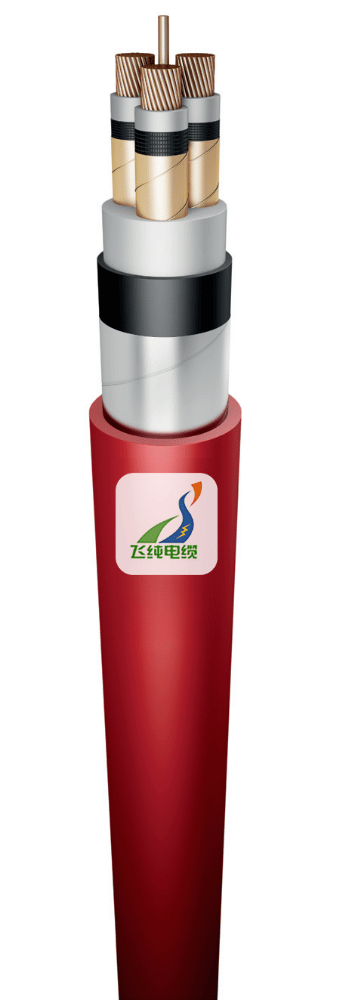Type YHKGYFoyn 3.6/6 kV Mining Power cables
Flame retardant explosion proof underground mining power cable with individually shielded copper conductors
With radial field, PVC insulation, PVC jacket, SWA armoring
Round steel with flame retardant PVC jacket


Type YHKGYFoyn cable is a flame retardant, explosion-proof power cable designed specifically for underground mining applications.
Engineered for hazardous environments, it delivers high reliability and safety in conditions where both mechanical stresses and potential explosive atmospheres exist.
It is intended for power transmission in circuits with a nominal voltage not exceeding 3.6/6 kV.
Construction and Materials
Conductors and Shielding
Compacted Copper Conductors:
The cable utilizes Class 2, round, compacted copper conductors in line with EN 60228.Individual Shielding:
Each copper conductor is individually shielded by two copper tapes arranged in a radial configuration. This shielding minimizes electromagnetic interference and enhances electrical performance.Screen Core:
Inside the twisted shield layers, a copper wire is installed to form a core, ensuring balanced electrical characteristics.
Insulation and Intermediate Layers
Primary Insulation:
The conductors are insulated using polywinit material (type DIV 14) according to PN-HD 620 S1:2002, which offers excellent dielectric properties.
Conductive Tape Layer:
A non-metallic conductive tape is applied over the insulation, further enhancing electrical stability.
Filling Layer:
A rubber blend filling is used within the cable assembly to ensure uniformity and structural integrity.
Sheath:
The cable is encased in a polywinit sheath (type DMV 31, per PN-HD 620 S1:2002) that provides primary mechanical protection and environmental resistance.
Armor and Protective Jacket
SWA Armoring:
Instead of tape armor, this cable is reinforced with galvanized round steel wires. This steel wire armor (SWA) adds robust mechanical protection against external damage.Flame-Retardant PVC Jacket:
The outer layer is a flame-retardant PVC jacket designed to prevent the spread of fire. This jacket not only provides an extra layer of safety but also contributes to the cable’s explosion-proof characteristics.
Key Characteristics
Electrical and Thermal Performance
Operating Temperature:
The cable’s conductors are designed to operate at temperatures up to +70°C.Installation Temperature Range:
Suitable for installation in environments ranging from –50°C to +50°C.Test Voltage:
Each cable undergoes a high-voltage (11 kV) proof test to verify insulation integrity.Bending Radius:
The minimum bending radius is specified as 12 times the cable’s overall outer diameter (12D), ensuring flexibility without compromising the cable structure.
Physical and Mechanical Properties
Color Coding:
The insulation is in a natural (uncolored) tone, while the outer jacket is red for clear identification.Packaging Options:
Typically supplied on drums with standard lengths of 500 or 1000 meters. Custom lengths and packaging configurations are available on request.Standards and Compliance:
The cable complies with the ZN-TF-202:2015 standard and meets RoHS93 directives, ensuring it is environmentally compliant.
Specifications and Performance Data
Cable Variants and Dimensions
The cable is available in several configurations (e.g., 3x25/16, 3x35/16, 3x50/16, 3x70/16, 3x95/16, 3x120/16, 3x150/25, 3x185/25). For each variant, the following parameters are provided:
Insulation Thickness: Approximately 3.4 mm across sizes.
Jacket Thickness: Ranges from 1.4 mm to 1.8 mm.
Armor Thickness: Varies from 2.6 mm to 3.4 mm.
Overall Cable Diameter: Varies with configuration (e.g., around 46.5 mm for 3x25/16 up to 74.0 mm for 3x185/25).
Cable Weight: Increases with size, from approximately 4664 kg/km to 14167 kg/km.
Conductor Resistance: Maximum resistance values at 20°C are provided in dual numbers (e.g., 0.727/1.15 Ω/km for the 3x25/16 variant).
Electrical Performance Metrics
Current Carrying Capacity:
Detailed tables list the current capacity for various conductor cross-sections at an ambient temperature of +25°C. For instance:A 25 mm² conductor carries approximately 117 A.
A 35 mm² conductor carries around 141 A.
Larger sizes (50 mm², 70 mm², etc.) follow similar scaling.
Inductive Properties:
The cable’s unit inductance and inductive reactance are specified per km. For example:A 25 mm² conductor exhibits an inductance of about 0.377 mH/km and a reactance of 0.119 Ω/km.
These values decrease slightly as the conductor cross-section increases.
Installation and Derating Considerations
Correction Factors for Parallel Installations
When cables are installed in parallel (stacked on supports), the effective current-carrying capacity must be reduced according to the following correction factors:
1 cable: 1.00
2 cables: 0.93
3 cables: 0.90
6 cables: 0.87
9 cables: 0.86
Ambient Temperature Corrections
For ambient temperatures higher than +25°C, correction factors must be applied to account for reduced current capacity:
30°C: 0.94
35°C: 0.88
40°C: 0.82
45°C: 0.75
50°C: 0.67
55°C: 0.58
Applications
The Type YHKGYFoyn 3.6/6 kV Mining Power Cable is specifically designed for underground mining applications. Its explosion-proof design, combined with flame-retardant properties and robust mechanical construction, makes it ideal for:
Transmitting electrical power in hazardous mining environments.
Withstanding high mechanical stresses and potential explosive atmospheres.
Delivering reliable performance in the challenging conditions encountered in underground mines.

Frequently Asked Questions (FAQ)
Q: What is the rated voltage of this cable?
A: The cable is designed for systems with a nominal voltage not exceeding 3.6/6 kV.
Q: What is the primary application of the Type YHKGYFoyn cable?
A: It is engineered for underground mining, particularly in hazardous areas where explosion-proof and flame-retardant features are essential.
Q: What type of conductors does the cable use?
A: It uses Class 2, round, compacted copper conductors compliant with EN 60228.
Q: How are the conductors shielded?
A: Each conductor is individually shielded with two copper tapes arranged in a radial configuration, minimizing electromagnetic interference.
Q: What material is used for the primary insulation?
A: The conductors are insulated with polywinit material (type DIV 14) in accordance with PN-HD 620 S1:2002.
Q: Is there an additional conductive layer in the cable?
A: Yes, a non-metallic conductive tape layer is applied to further stabilize electrical performance.
Q: What is the function of the rubber blend filling layer?
A: It ensures uniformity and structural integrity within the cable assembly.
Q: What type of sheath is used for mechanical protection?
A: The cable features a polywinit sheath (type DMV 31) that offers environmental resistance and primary mechanical protection.
Q: How is the cable armored?
A: Instead of tape armor, it is reinforced with galvanized round steel wires (SWA), providing robust mechanical protection.
Q: What does SWA stand for?
A: SWA stands for Steel Wire Armor.
Q: What is the main advantage of SWA armoring in mining applications?
A: It offers enhanced durability and protects the cable from physical damage in harsh underground conditions.
Q: What is the outer protective jacket made of?
A: The outer jacket is a flame-retardant PVC designed to prevent fire spread.
Q: How does the flame-retardant jacket contribute to safety?
A: It helps to contain fires and minimizes the risk of explosions in hazardous mining environments.
Q: What is the typical color coding of the cable?
A: The insulation is natural, while the outer jacket is red, ensuring clear visual identification.
Q: What operating temperature can the conductors withstand?
A: The conductors are rated to operate up to +70°C.
Q: What is the installation temperature range for this cable?
A: The cable can be installed in environments ranging from –50°C to +50°C.
Q: At what voltage is the cable proof-tested?
A: It undergoes an 11 kV proof test to ensure insulation integrity.
Q: What is the minimum bending radius for the cable?
A: The cable must not be bent to a radius smaller than 12 times its outer diameter (12D).
Q: In what standard is the cable constructed?
A: It conforms to the ZN-TF-202:2015 standard.
Q: Is the cable RoHS compliant?
A: Yes, it meets RoHS93 requirements, ensuring environmental safety through restricted hazardous substances.
Q: What is the significance of the radial field configuration?
A: A radial field minimizes electromagnetic interference and ensures uniform current distribution, critical in noisy mining environments.
Q: What conductor cross-sectional areas are available?
A: Options include configurations like 3x25/16, 3x35/16, 3x50/16, 3x70/16, 3x95/16, 3x120/16, 3x150/25, and 3x185/25.
Q: How does the conductor cross-section affect cable performance?
A: Larger cross-sections allow for higher current capacity and lower resistance, which is vital for heavy-duty mining applications.
Q: What electrical properties are detailed in the cable specifications?
A: The specifications include current carrying capacity, unit inductance (mH/km), and unit inductive reactance (Ω/km) for each conductor size.
Q: How does ambient temperature influence current capacity?
A: Higher ambient temperatures require the application of correction factors to reduce the effective current carrying capacity.
Q: What are the correction factors for parallel cable installations?
A: For cables installed together on supports, correction factors such as 1.00 (1 cable), 0.93 (2 cables), 0.90 (3 cables), 0.87 (6 cables), and 0.86 (9 cables) must be applied.
Q: How are ambient temperature correction factors applied?
A: They adjust the current carrying capacity for temperatures above +25°C—for example, 0.94 at 30°C, 0.88 at 35°C, and so on.
Q: What mechanical stresses is this cable designed to withstand?
A: Its robust construction—including SWA armoring and a durable, flame-retardant PVC jacket—ensures it can handle the mechanical challenges of underground mining.
Q: Why is individual shielding important for this cable?
A: It minimizes cross-talk and interference, which is crucial for maintaining performance in electrically noisy and hazardous environments.
Q: How is the cable typically packaged?
A: It is usually supplied on drums with standard lengths of 500 or 1000 meters, although custom packaging options are available.
Q: How does this cable meet the demanding requirements of underground mining?
A: Its explosion-proof design, flame-retardant construction, individually shielded conductors, and robust mechanical armoring make it ideal for safe and reliable power transmission in challenging mining environments.






Type YHKGYFoyn 3.6/6 kV Mining Power Cable
A flame-retardant, explosion-proof underground cable engineered for the harsh conditions of mining environments. This high-performance cable features individually shielded, compacted copper conductors with radial field design, advanced PVC insulation, and a robust polywinit sheath. Reinforced with galvanized round steel wire armoring (SWA) and protected by a red, flame-retardant PVC jacket, it ensures superior electrical stability, mechanical durability, and fire resistance. Compliant with ZN-TF-202:2015 and RoHS93 standards, it operates safely in extreme temperatures from –50°C to +70°C, making it the ideal solution for reliable power distribution in underground mining applications.
6/30/20217 min read
